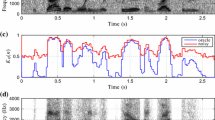Abstract
A new signal subspace-based approach is proposed for the enhancement of speech corrupted by a high level of noise. Conventional subspace-based methods use the minimum mean square error criterion to optimize the Karhunen-Loève Transform (KLT). In non-stationary noisy environments, the selection of the optimal order of the KLT-based speech enhancement model is a critical issue. Indeed, estimation of the relevant subspace dimensions depends on the environmental conditions that may change unpredictably. Therefore, a drastic KLT-based dimension reduction may induce the loss of relevant components of speech and conversely, a reconstruction using a higher order of the KLT model will be ineffective to remove the noise. The method presented in this paper uses a Variance of Reconstruction Error (VRE) criterion to optimally select the KLT order model. A prominent point of this subspace method is that it incorporates the Minima Controlled Recursive Averaging (MCRA) to estimate the noise Power Spectral Density (PSD) used in the gain function. Three variants of the VRE combined with MCRA methods are implemented and compared, namely the VRE-MCRA, VRE-MCRA2 and VRE-IMCRA. Objective measures show that VRE-based approaches achieve a lower signal distortion and a higher noise reduction than existing enhancement methods.


Similar content being viewed by others
Explore related subjects
Discover the latest articles, news and stories from top researchers in related subjects.References
Abolhassani, A., Selouani, S. A., O’Shaughnessy, D., Harkat, M. F. (2007). Speech enhancement using PCA and variance of the reconstruction error model identification. In: Interspeech’ 2007 proceedings, Antwerp., pp. 974–977.
Ben Aicha, A., & Ben Jebara, S. (2007). Perceptual musical noise reduction using critical band tonality coefficients and masking thresholds. In: Interspeech 2007 proceedings, Antwerp., pp. 822–825.
Berouti, M., Schwartz, R., & Makhoul, J. (1979). Enhancement of speech corrupted by acoustic noise. In: IEEE ICASSP’79 proceedings, Washington, DC, pp. 208–211.
Boll, S. (1979). Suppression of acoustic noise in speech using spectral subtraction. IEEE Transactions on Acoustics, Speech, and Signal Processing, 27(2), 113–120.
Ching-Ta, I. (2011). Enhancement of single channel speech using perceptual-decision-directed approach. Speech Communication, 53(4), 495–507.
Cohen, I. (2003). Noise spectrum estimation in adverse environments: improved minima controlled recursive averaging. IEEE Transactions on Speech and Audio Processing, 11(5), 466–475.
Cohen, I., & Berdugo, B. (2002). Noise estimation by minima controlled recursive averaging for robust speech enhancement. IEEE Signal Processing Letters, 9(1), 12–15.
Dendrinos, M., Bakamides, S., & Carayannis, G. (1991). Speech enhancement from noise: a regenerative approach. Speech Communication, 10, 45–57.
Ephraim, Y., & Malah, D. (1984). Speech enhancement using MMSE short-time spectral amplitude estimator. EEE Transactions on Acoustics, Speech, and Signal Processing, 32(6), 1109–1121.
Ephraim, Y., & Malah, D. (1985). Speech enhancement using a minimum mean-square error log-spectral amplitude estimator. EEE Transactions on Acoustics, Speech, and Signal Processing, 23(2), 443–445.
Ephraim, Y., & Van Trees, H. L. (1995). A signal subspace approach for speech enhancement. IEEE Transactions on Speech and Audio Processing, 3(4), 251–266.
Hu, Y., & Loizou, P. C. (2003). A generalized subspace approach for enhancing speech corrupted by colored noise. IEEE Transactions on Speech and Audio Processing 11, 334–341.
Hu, Y., & Loizou, P. C. (2007). Subjective evaluation and comparison of speech enhancement algorithms. Speech Communication, 49, 588–601. (NOIZEUS: a noisy speech corpus for evaluation of speech enhancement algorithms. Available at: http://www.utdallas.edu/~loizou/speech/noizeus/).
Johnston, J. D. (1988). Transform coding of audio signal using perceptual noise criteria. IEEE Journal on Selected Areas in Communications, 6(2), 314–323.
Loizou, P. C. (2007). Speech enhancement theory and practice (1st edn.). Boca Raton: CRC Press.
Rangachari, S., & Loizou, P. C. (2006). A noise estimation algorithm for highly non-stationary environments. Speech Communication, 28, 220–231.
Selouani, S. A. (2011). Speech processing and soft computing. Springer briefs in speech technology. Springer, Berlin.
Scalart, P., & Filho, J. V. (1996). Speech enhancement based on a priori signal to noise estimation. In: IEEE ICASSP ’96 proceedings, Atlanta, pp. 629–632.
Author information
Authors and Affiliations
Corresponding author
Rights and permissions
About this article
Cite this article
Saadoune, A., Amrouche, A. & Selouani, S.A. MCRA noise estimation for KLT-VRE-based speech enhancement. Int J Speech Technol 16, 333–339 (2013). https://doi.org/10.1007/s10772-012-9186-9
Received:
Accepted:
Published:
Issue Date:
DOI: https://doi.org/10.1007/s10772-012-9186-9




